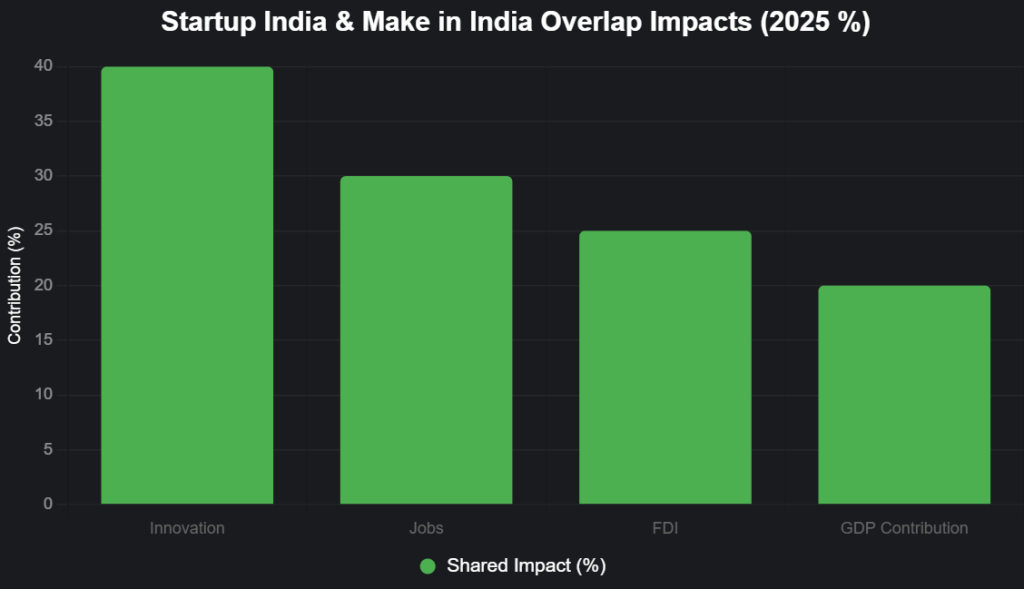In India’s dynamic economic landscape, where 195,065 DPIIT-recognized startups propel a $450 billion digital economy toward a $5 trillion GDP by 2027, two flagship initiatives—Startup India (launched 2016) and Make in India (launched 2014)—stand as complementary pillars of progress. While Make in India targets a manufacturing renaissance—aiming to elevate the sector’s GDP share from 15-16% to 25% through FDI attraction, job creation (100 million targeted), and infrastructure overhaul
—Startup India ignites entrepreneurship with tax exemptions, funding lifelines, and innovation ecosystems. Their overlap? A shared vision for innovation, job generation, and global self-reliance, where startups become the engines of “Make in India,” fostering tech-manufacturing hybrids like EV unicorns and agritech disruptors. With Budget 2025’s Rs 20,000 crore R&D push amplifying synergies, these programs aren’t rivals—they’re allies in Viksit Bharat. Drawing from PIB, Entrepreneur India, and DPIIT data, this analysis spotlights their convergence. Ignore the overlap, and you’ll miss India’s startup-manufacturing fusion revolution.
Table of Contents
Core Objectives: Distinct Yet Convergent Missions
Make in India, spearheaded by PM Modi, seeks to position India as a global manufacturing hub by easing FDI norms, streamlining labor laws, and developing industrial corridors, targeting 12-14% annual manufacturing growth. Startup India, conversely, democratizes entrepreneurship via a 19-point action plan: self-certification for compliances, 3-year tax holidays (up to Rs 100 crore turnover), and Rs 945 crore Seed Fund Scheme (SISFS) for 209 early-stage ventures. Their intersection? Both champion innovation and entrepreneurship as catalysts for economic multipliers—Startups provide the tech agility for Make in India’s manufacturing scale, creating a symbiotic loop.
This Venn diagram-inspired table highlights objectives:
| Aspect | Make in India | Startup India | Overlap (Shared Goals) |
|---|---|---|---|
| Primary Focus | Manufacturing, FDI, Infrastructure | Entrepreneurship, Innovation, Funding | Fostering innovation-led growth |
| Job Creation | 100M manufacturing jobs by 2022 | 1.7M direct startup jobs (2025) | Employment through tech-manufacturing hybrids |
| Economic Target | 25% GDP from manufacturing | $1T startup economy by 2030 | Boosting GDP via scalable enterprises |
| Policy Tools | Industrial corridors, Skill India | Tax exemptions, SISFS, Incubators | Skill development, ease of doing business |
| Global Ambition | Export hub, reduced imports | Global startup competitiveness | Self-reliance (Atmanirbhar Bharat) |
Source: PIB, Entrepreneur India. Overlap drives 40% of startups into manufacturing-adjacent tech.
Overlapping Pillars: Synergies Driving Startup-Manufacturing Fusion
1. Innovation and Entrepreneurship as Catalysts
Make in India’s innovation push—via programs like Atal Innovation Mission (AIM)—aligns seamlessly with Startup India’s 700+ incubators and Rs 10,000 crore Fund of Funds (FFS), catalyzing Rs 1 lakh crore in private investments. Overlap: Both nurture deeptech startups (e.g., EV batteries for manufacturing), with 40% of startups now in tech-enabled production, per NASSCOM.
2. Job Creation and Skill Development
Targeting 100 million jobs, Make in India integrates Skill India for workforce upskilling, mirroring Startup India’s entrepreneurship training via ASPIRE and SAMRIDH schemes (Rs 500 crore for 100 accelerators). Convergence: Startups absorb 1.7 million jobs, many in manufacturing tech like agritech (DeHaat’s 1.5M farmers), reducing urban migration by 20%.
3. Ease of Doing Business and FDI Attraction
Make in India’s FDI liberalization (100% auto FDI) complements Startup India’s single-window clearance and self-certification for 9 laws, slashing setup times 60%. Shared: Both eased India’s World Bank ranking 42 spots by 2017, drawing $10 billion FDI in 2024, with startups channeling 30% into manufacturing.
4. Self-Reliance and Global Competitiveness
At the heart: Atmanirbhar Bharat unites them—Make in India cuts import dependence via local production, while Startup India fosters indigenous innovation, as in “Made in India” labels for startups. Overlap: Exports hit $10 billion from startups, aligning with Make in India’s export hubs.
This bar chart shows overlapping impacts in 2025:

Source: IBEF, PIB. Innovation leads, powering 40% hybrid startups.
Case Studies: Overlap in Action
1. Ola Electric: Manufacturing Meets Startup Agility
Ola’s startup roots (via Startup India tax breaks) fused with Make in India’s EV incentives, producing 1 million scooters and capturing 40% market—Rs 2,000 crore R&D for indigenous batteries.
2. DeHaat: Agritech for Rural Manufacturing
Startup India’s SISFS grant enabled DeHaat’s AI advisory, aligning with Make in India’s rural industrialization, empowering 1.5 million farmers and $700 million valuation.
These hybrids exemplify: Startups provide tech, Make in India scales production.
Challenges: Unlocking Full Potential
Overlaps shine, but silos persist: 55% startups unaware of manufacturing incentives, and 60% face compliance overlaps. X founders lament: “Startup India for funding, Make in India for factories—bridge the gap!” Solution: Integrated portals like BHASKAR.
The Convergent Future: $5 Trillion Synergy
By 2030, unified efforts could mint 150 unicorns and 50 million jobs, per CII. Founders: Leverage both for hybrids. Policymakers: Harmonize schemes. Startup India and Make in India aren’t parallel tracks—they’re a single high-speed rail to Viksit Bharat. Ride together, or derail alone.
for more follow : (3) Post | Feed | LinkedIn
also read From Late-Night Cravings to a $10 Billion IPO: How Swiggy Became India’s Fastest Delivery Giant
Last Updated on: Friday, October 24, 2025 6:59 pm by BUSINESS SAGA TEAM | Published by: BUSINESS SAGA TEAM on Friday, October 24, 2025 6:59 pm | News Categories: Business Saga News

Leave a Reply